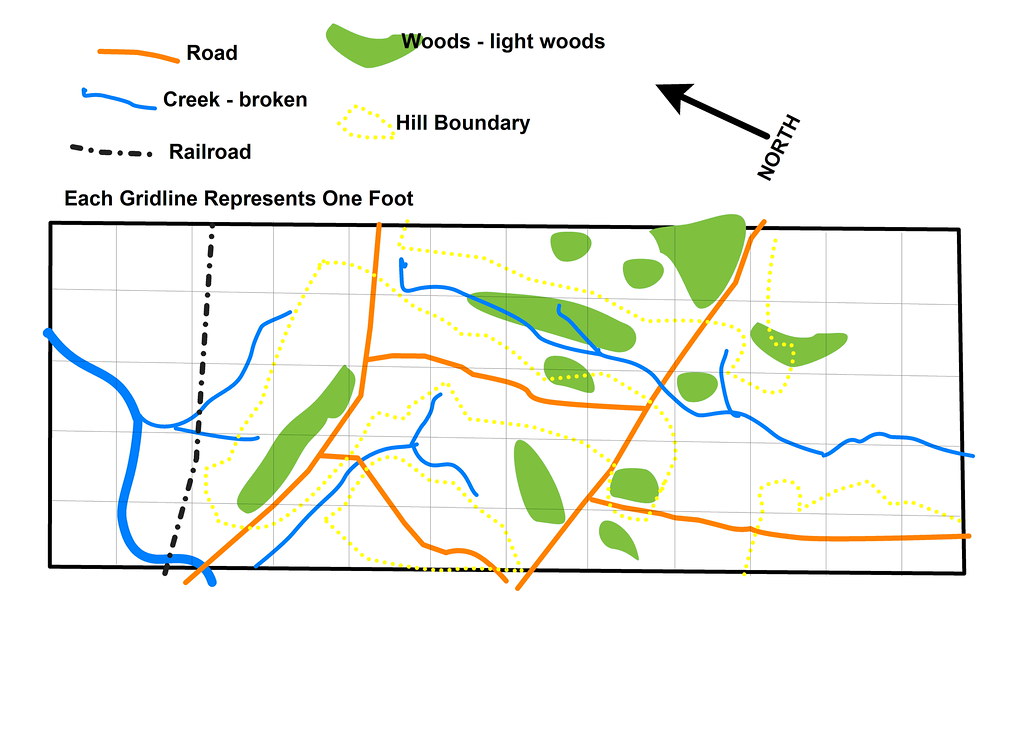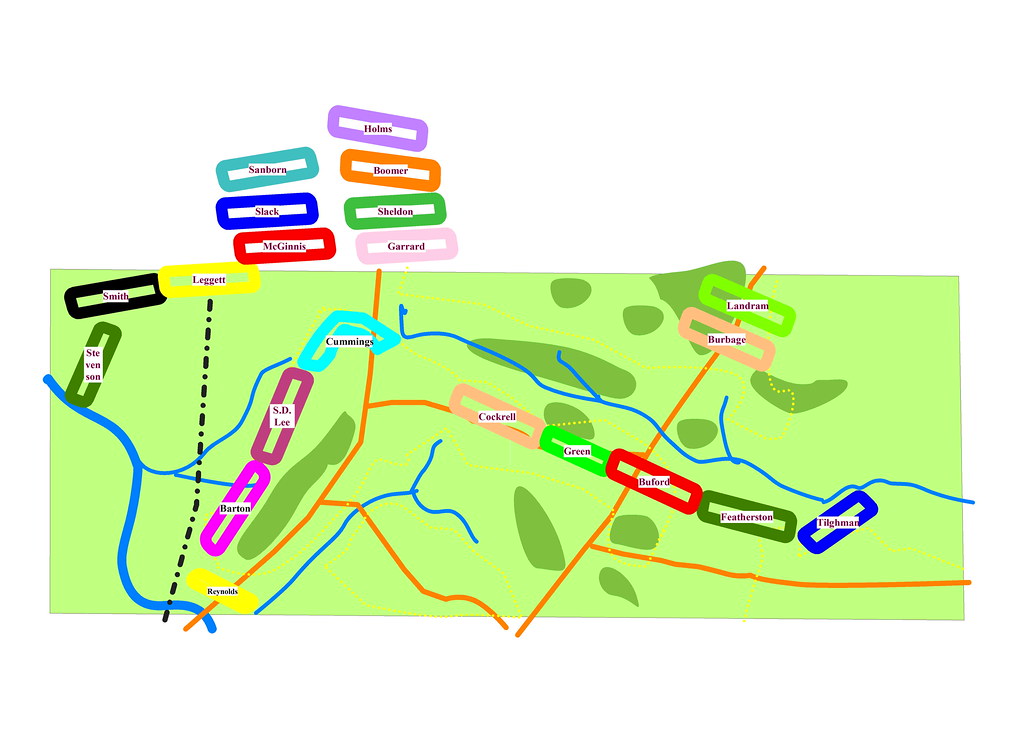Vicksburg Campaign
Battle of Champion Hill
May 16, 1863
Historical Background:
Champion Hill, the decisive battle of the Vicksburg Campaign, began about 7:00 a.m. Lieutenant General John C. Pemberton, the Confederate commander, deployed his three divisions in a three mile-long battle line that ran from southwest to northeast along a ridge overlooking Jackson Creek. His position was suited for defense and was especially formidable against attacks along the Middle and Raymond roads. He was, however, unaware that one of the three Union columns was pushing down the Jackson Road toward his unprotected left flank on Champion Hill. If unchecked, this Union force could capture Edwards and cut the Confederates off from their base of operation - Vicksburg. Shortly aft 9:00 a.m. a courier brought warning of the Federal advance along the Jackson Road. Confederate troops were shifted to the left to cover Champion Hill and protect the vital crossroads. Federal soldiers arrived near the Champion house, swung from column into double line of battle and unlimbered their artillery. The battle roared into action.
Major General Grant established his headquarters at the Champion house. He ordered his 10,000 men on the Jackson Road to move forward in magnificent style with flags flying. The long blue lines extended westward beyond the Confederate flank. To meet this threat, Confederate troops shifted farther to the west creating a gap between the forces defending the crossroads and those defending the Raymond Road.
By 11:30 a.m. the Federals closed in on the Confederate main line of resistance. With a cheer they stormed the position. The fighting was intense as the battle raged on Champion Hill. The lines swayed back and forth as charge and countercharge were made. Shortly after 1:00 p.m. the strength of numbers prevailed. The blue tide swept over the crest of Champion Hill.
The Confederates fell back in disorder to the Jackson Road followed closely by the hard-driving Federals. The powerful Union drive captured the crossroads and severed the Jackson Road escape route. Confronted by disaster, Pemberton ordered his two remaining divisions to counterattack. Leaving one brigade to guard the Raymond Road, the Confederates moved from their right along the Ratliff Road toward the crossroads. Brigadier General John S. Bowen's 4,500 men attacked the Federals near the crossroads. Using bayonets they drove the Federals back and gained control of Champion Hill. Outnumbered, the Confederate attack faltered short of the Champion house.
Grant ordered up fresh troops to drive back the Confederates and moved the Federals forward along the Middle and Raymond roads. Confederate resistance was shattered and Pemberton ordered his army from the field.
Federal combat strength: 32,000. Casualties: 2,441.
Confederate combat strength: 22,000. Casualties: 3,840.
Source: "A Guide to the Campaign & Siege of Vicksburg", State of Mississippi, Department of Archives and History, 1994.
Pre-Battle Perspectives and Victory Conditions:
Confederate:
Lieutenant General John C. Pemberton, commanding the Confederate Army at Vicksburg Mississippi, had conflicting orders. The President of the Confederacy, Jefferson Davis, early in the war had ordered Pemberton to hold the city of Vicksburg at all costs and thereby deny the Union army use of the Mississippi River. Pemberton’s recently assigned superior, General Joseph E. Johnston, had been sending repeated orders for Pemberton to move most of his forces out of Vicksburg in order to achieve a link up with Johnston’s forces operating in eastern Mississippi. Pemberton’s actions had vacillated between these two competing goals several times over the weeks preceding the Battle of Champion’s Hill.
On May 13th, Pemberton marched most of his force southeast out of Vicksburg to harass U.S. Grant’s supply line and with luck, catch a portion of the Union army in the rear as it focused it’s attention on Johnston’s forces operating in eastern Mississippi. This operation was designed to keep the Federals away from Vicksburg by keeping Pemberton’s large Confederate force between Vicksburg and the approaching Union army. An action in support of the orders from his first master, Jefferson Davis.
On May 15th, Pemberton received yet another order from Johnston, to march northeast to achieve the desired linkup. So, in order to please his second master, General Johnston, Pemberton ordered a complete countermarch of his entire force and began moving for the link up with Fighting Joe.
It’s at this juncture that the Battle of Champion’s Hill occurs.
Rebel Victory Conditions
In this game, the Confederate forces must decide which John C. Pemberton they work for.
• CHOICE A: The Pemberton whose goal is to inflict damage on the Union army marching on Vicksburg in order to discourage any attack on the river city.
Choice A’s Victory Conditions:
• 1 point for every Union Infantry or Artillery stand destroyed or routed from the tabletop.
• An additional bonus point will be awarded for every 10 Union stands destroyed or routed from the tabletop.
• 2 points for every Union General removed from the tabletop. (4,5, or 6 on the officer casualty results roll)
• 10 points for killing Ulysses S. Grant.
For example: If 23 stands of Union have been eliminated then the Confederate would have a total of 25 points.
• CHOICE B: The Pemberton whose goal is to break through the approaching Federal army in order to combine forces with his commanding officer and carry the fight to U.S. Grant on a day of the South’s choosing.
Choice B’s Victory Conditions:
• 1 point for every Confederate Infantry or Artillery stand that exits the tabletop off the eastern edge.
• Additional 5 bonus points will be awarded for every infantry brigade that completely exits the tabletop. (no remaining stands left on the tabletop and at least one regiment escaped off board)
• 2 points for every Confederate General which escapes from the tabletop.
• 10 points for killing Ulysses S. Grant.
Note: All Confederate routs must be generally toward the west.
The Confederate team must decide in advance of the battle if they will pursue strategy A or B and stick with the choice for the remainder of the scenario.
Union:
Ulysses S. Grant is a man on a mission. Seize the city of Vicksburg and open the mighty Mississippi from source to delta to Federal gunboats and transports. The capture of the city will split the confederacy in two and deny the Rebels in the east valuable men and materials in the war for succession. Grant has skillfully advanced the Federal army towards the city, defeating the Confederates in three major battles in less than a month. John C. Pemberton’s Confederate forces have marched defiantly from the city to face the Federal army in the field. The Rebel brigades are deployed across a ridgeline known locally as Champion’s Hill. If the Union army can destroy Pemberton’s army here, they can avoid a risky attack on the city’s entrenchments.
It’s under these circumstances that the Battle of Champion’s Hill begins:
Union Victory Conditions
• 1 point for every Rebel Infantry or Artillery stand destroyed or routed from the tabletop.
• An additional bonus point will be awarded for every 10 Rebel stands destroyed or routed from the tabletop.
• 2 points for every Rebel General removed from the tabletop. (4,5, or 6 on the officer casualty results roll)
• 10 points for killing Lt. Gen. John Pemberton
For example: If 23 stands of Confederates have been eliminated then the Union would have a total of 25 points.
Scenario Time Limit:
The game ends after 20 turns. However, victory conditions will likely determine an undisputed winner before the time limit expires so it is recommended that you keep track of victory points as you go.
Scenario Notes:
This is a large scenario designed originally to be used at gaming conventions with a large number of players. It requires players accustomed to controlling large forces and multiple commands.
Table Top Map:

Deployment Map - Union and Confederate Forces

Order Of Battle






